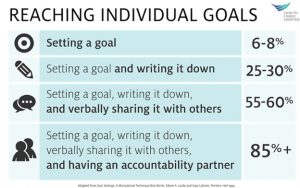
Compelling Goals
Have you ever set a goal that you were sure to achieve but then procrastination crept in or for any other reason (let’s be honest excuse) you just were unable to complete? If so, first calm down because it just means you are a normal human being. Here is a step by step to set goals that get your subconscious mind compelled and engaged to achieve.
Step 1. Create a positive, specific goal.
State your outcome/goal in positive, specific terms. Take the time to describe exactly what you want. But be careful, a negative goal does not take you in this positive direction. Avoid goals such as, ” I do not want to be a perfectionist.” It is mainly because a “not frame” encourages the subconscious mind to create what you think you are resisting. If you erase a problem and replace it with something positive and resourceful, what would it be? Describe it. Include all key sense modes.
Step 2. State your outcome in terms of ability, not lack of ability.
Consider, ” I want others to support me.” That is not a well-formed outcome. Actually, thinking this way will stop you from making progress! It is true that some goals require support from additional people, but this vague outcome doesn’t say what you will do to get the support and what, exactly, that support entails.
Note that the outcome needs to be based on YOUR actions. Plus, it must be within YOUR
RESPONSIBILITY and ABILITY. Ask yourself:
- What could you do on your own to make it happen?
- What actions would you take to increase your chances this week?
Step 3. Put it in Context
Nothing has meaning outside of its context. Describe your well-formed outcome in the context of the environment it will be in. This makes your goal more specific and motivational. It also helps to make sure that you have created an ecological goal. A more well-formed, context-related outcome would be: “I want to make $80,000 within the next 12 months, starting July 1st, by selling my trainings to national and multinational corporations.”
You need to add places, locations, geography, people and their titles, a budget, time frames and more. By making it specific and context related, you’re making it real for your brain.
Step 4. Engage Sense Modalities
Describe your outcome by using your five senses. A well-formed outcome is specific. By adding all senses, you are being more specific and, again, motivational. This adds power to your positive subconscious strategies. If you have to use a word such as love, appreciated, or passionate, be sure to include the senses that form that emotion. From a sensory point of view, what does it mean for you to feel more appreciated?
- How does ‘appreciated’ feel?
- In what part of your body do you feel it?
- Who is appreciating you, and what kind of expression is on their face?
Step 5. Set Objectives
Break down your goal into manageable objectives (pieces/steps), so that you will feel more motivation and do better problem solving. Be sure to define the objectives in achievable terms. Smaller steps feel more achievable. This adds subconscious motivation. In NLP we call this breakdown “chunking down.”
- How do you feel when you think about writing a whole book?
- Or losing 60 pounds?
Compare that to smaller pieces. “I will write a page a day to complete a 240 pages book. Today I will concentrate only on that one page.”
How do you eat an elephant? One piece at a time.
Step 6. Gain Support
Arrange the help you need in order to make this outcome a reality. What resources do you need? Make a list of the resources you will use in attaining your goal. Let’s say an important resource is team members, and a resource for acquiring them is a persuasive pitch.
“By the end of the week, I will have a complete list of people that are good candidates for teaming up on this project. By the end of the following week, I will have created a persuasive approach for contacting them, and I will have called at least twenty of them. I will continue until I have five credible commitments.”
Again, be specific:
- Who are the people who can assist you?
- What are their names?
- What is their profession?
- How about their phone numbers?
- What, exactly, should you ask them?
- What emotions will you need to develop within yourself?
- Do you need more confidence, resilience, joyfulness, or assertiveness?
- How much money?
- What information will be important? What questions must be answered
- ahead of time?
- What else do you need?
Step 7. Perform an ecology check
Be honest and skeptical with yourself now. Ask yourself:
- What might be interfering with your goal?
- Are there any values, other goals, people, or laws that may be challenging?
- How might you accommodate or mitigate now in order to make your dream a reality?
- Consider any internal obstacles you may have. Is a part of you interfering with your goal?
Step 8. Create your milestones.
If it gets measured it gets done. There are many benefits to writing down your goals, objectives and milestones. Having a notebook or file for this gives you a place for problem solving and innovation. Sometimes a stray thought will turn into a gold mine when you come across it later. Having separate sections for these elements gives you a working reference for checking milestones, refining your goals, and working toward your objectives. Unwritten goals aren’t worth the paper they’re written on, but the written word is powerful.
Think about it, Wouldn’t it be worse to SEE your name on a “Most Wanted” poster than to HEAR about it?
Research by Center for Creative Leadership suggest that goals if written and shared with an accountability partner have more than 85% chances to complete.

Step 10. Test Your Self
Monitor your progress on the goal and its milestones regularly. Notice any ways that this pattern of goal setting and actions has helped you make progress toward achieving your goal. Do this pattern as needed for other goals and for refining this goal. Notice any ways that this pattern has improved your willingness to be more conscious of your goals and milestones, and to commit yourself to them.
Leave a Reply